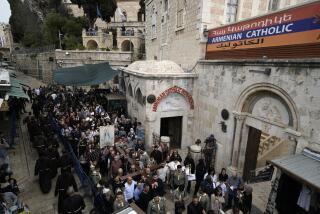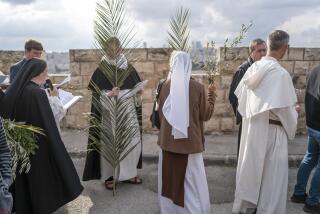Armed Soldiers--as Always--at Site of Christ’s Baptism
- Share via
JORDAN RIVER, Occupied West Bank — A slight breeze stirs the reeds and rushes. The water flows so slowly it seems still. At this tranquil curve of the Jordan, tradition has it, Jesus was immersed by St. John the Baptist.
The illusion of peace is fleeting.
Coils of barbed wire rim the river a few steps away. An Israeli army truck carrying three men with machine guns has led the way to the baptismal site, passing signs that say in English, Hebrew and Arabic: “Danger--Mines.”
Jesus Christ, the Prince of Peace, spent his life in what has been for centuries a land of war. The sites of his birth, baptism and burial are on disputed land still fought over by Israelis and Palestinians.
In Bethlehem again this year, hundreds of armed Israeli soldiers will guard the square surrounding the Church of the Nativity on Christmas Eve because of the 3-year-old Palestinian uprising.
The city’s mayor, Elias Freij, a Greek Orthodox Christian, has ordered municipal Christmas celebrations canceled for the fourth year in sympathy with the uprising against Israel’s occupation of the West Bank and Gaza Strip.
Earlier this year, a Palestinian flag flew from the Church of the Holy Sepulcher, the site of Christ’s burial in Jerusalem, to protest Jewish settlers trying to take over a hostel owned by the Greek Orthodox Church.
Here on the Jordan, the site of Christ’s baptism lies in the no-man’s-land along the Israeli-Jordanian frontier--beyond a fence topped with barbed wire, surrounded by bunkers and mines.
The area is usually opened only twice a year: on Jan. 18, the eve of the Greek Orthodox Epiphany, or 12th day of Christmas, marking the revelation of Jesus as the Christ, and in October for a baptism ceremony by the Roman Catholic Franciscan order.
This year, Israel’s Tourism Ministry opened it for reporters as part of a pre-Christmas tour that concentrated on Christ’s baptism and wanderings in the Judean desert.
His journey from Galilee to the Jordan, and the baptism, are described in Matthew 3:13-17: “And Jesus, when he was baptized, went up straightway out of the water: and lo, the heavens were opened unto him, and he saw the Spirit of God descending like a dove, and lighting upon him:
“And lo a voice from heaven, saying, ‘This is my beloved Son, in whom I am well pleased.’ ”
After his baptism, Jesus went into the surrounding desert and was tempted by the devil for 40 days, the Bible says. The Monastery of the Temptation, on a cliff west of Jericho, stands where tradition says he rejected Satan’s coaxing.
To understand Christ’s life in the desert, monks for hundreds of years have lived along the river and in the rugged hills above the Jordan Valley. Up to 100 monasteries had been built by the time a Persian invasion destroyed them in the 7th Century.
That was but one chapter in a history of war that extends from the ancient battles of the Philistines, Canaanites and Israelites to modern world wars and the five Arab-Israeli conflicts.
Eleven monasteries stood along the Jordan near the baptismal site in recent times, but Israel closed the area along the bank in 1970 because of attacks from Jordan by Palestinians hoping to regain their homeland.
David Bivin, a Christian biblical scholar who helped guide the reporters, said it was here that Jesus received the inspiration for his later life from the bat kol-- Hebrew for divine voice--that spoke from the skies after his baptism.
“Perhaps the real mission of Jesus began in the wilderness with that announcement,” Bivin said.
From the Jordan, Jesus went to the desert and from there returned to Galilee to deliver the Sermon on the Mount, the Bible says.
His message, in Matthew 5:9, still speaks to the land of his birth: “Blessed are the peacemakers, for they shall be called the children of God.”
More to Read
Sign up for Essential California
The most important California stories and recommendations in your inbox every morning.
You may occasionally receive promotional content from the Los Angeles Times.













